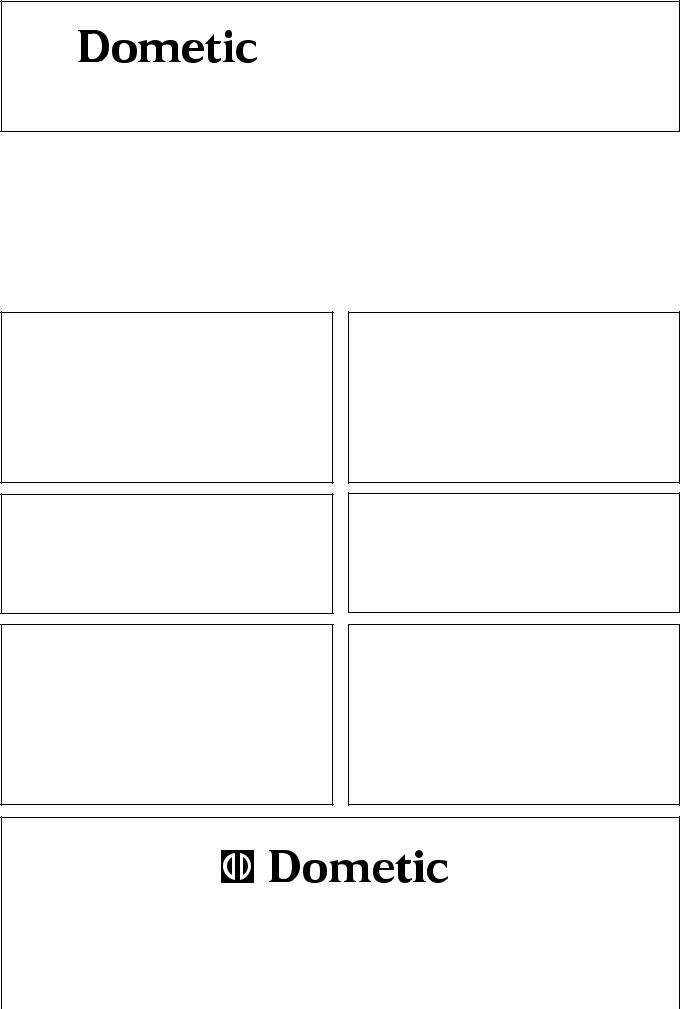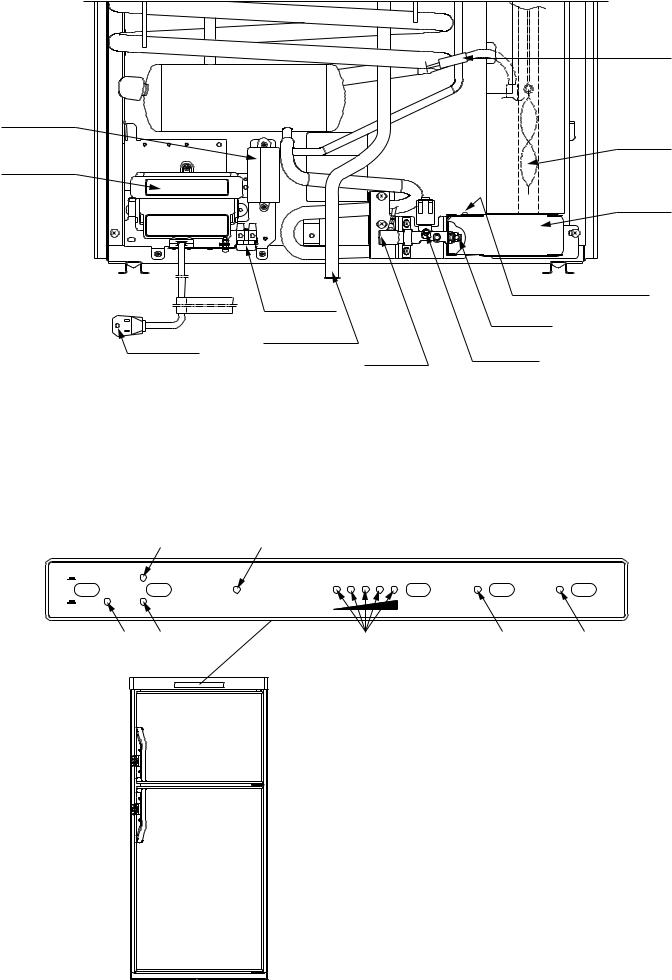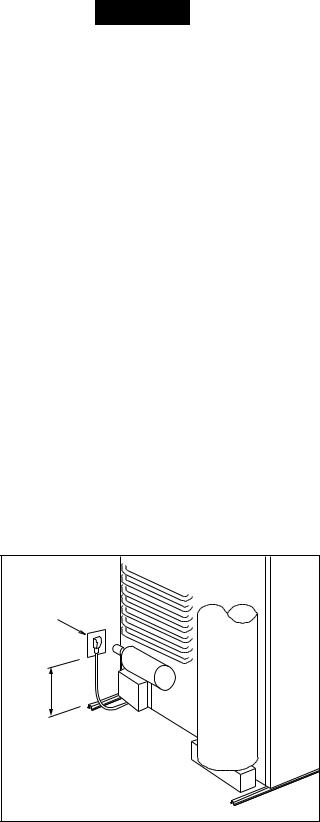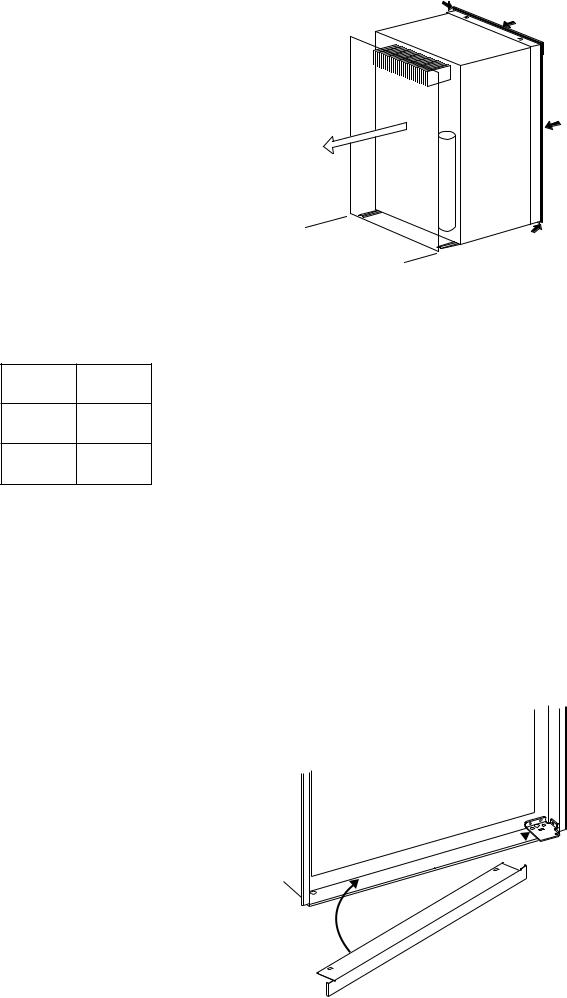Dometic RM3862 User Manual

|
® |
INSTALLATION AND |
|
|
OPERATING INSTRUCTIONS |
|
|
REFRIGERATOR FOR LP-GAS AND ELECTRIC OPERATION
RM3862
RM 3862
FOR YOUR SAFETY
If you smell gas:
1.Open windows.
2.Don’t touch electrical switches.
3.Extinguish any open flame.
4.Immediately call your gas supplier.
FOR YOUR SAFETY
Do not store or use gasoline or other flammable vapors and liquids in the vicinity of this or any other appliance.
WARNING: Improper installation, adjustment, alteration, service or maintenance can cause injury or property damage. Refer to this manual. For assistance or additional information consult a qualified installer, service agency or the gas supplier.
Contents: |
|
|
Page |
Installation |
4 |
Operating Instructions |
8 |
Maintenance & Service |
12 |
Pour votre sécurité
Si vous sentez une odeur de gaz:
1.Ouvrez les fenêtres.
2.Ne touchez à aucun interrupteur.
3.Éteignez toute flamme nue.
4.Avertissez immédiatement votre fournisseur de gaz.
Pour votre sécurité
Ne pas entreposer ni utiliser de l’essence ni d’autres vapeurs ou liquides inflammables à proximité de cet appareil ou de tout autre appareil.
Avertissement: Une installation, un réglage, une modification, une réparation ou un entretien non conforme aux normes peut entraîner des blessures ou des dommages matériels. Lisez attentivement le mode d’emploi fourni avec l’appareil. Pour obtenir de l’aide ou des renseignements supplémentaires, consultez un installateur ou un service d’entretien qualifié ou le fournisseur de gaz.
®
USA |
Corporate Office |
CANADA |
Service Office |
2320 Industrial Parkway Elkhart, IN 46515 |
Dometic Distribution Inc. |
Dometic Corporation |
|
866 Langs Drive |
509 South Poplar Street |
|
Cambridge, Ontario |
LaGrange, IN 46761 |
For Service Center Assistance |
N3H 2N7 Canada |
Phone: 260-463-4858 |
Call: 800-544-4881 |
Phone: 519-653-4390 |
|
|
|
12 24- 0 |
|
|
825122400 |
|
|

Heater
Cover,
Reigniter
Flue baffle
Power module cover
|
|
|
|
Protection |
|
|
|
|
cover |
|
|
12V DC |
|
|
|
|
12 volt |
|
Screw for protection cover |
|
|
|
|
|
FIG. 1 |
|
Terminal block |
|
|
|
|
|
Burner jet |
|
|
Flexible cord |
Drain water hose |
|
Manual gas |
|
|
|
||
|
|
|
shutoff valve |
|
|
|
|
Inlet fitting |
|
|
|
|
|
|
|
Refrigerator control panel |
|
|
|
B |
D |
|
|
ON |
AES |
COLD 1 2 3 4 5 COLDEST |
CLC |
LAC |
AUTO |
||||
1 |
2 |
3 |
4 |
5 |
OFF AC |
GAS |
CHECK |
|
|
A |
C |
E |
F |
G |
LEGEND 2-WAY AES Model
1. Main Power Button ON/OFF
2. AES/AUTO/GAS Mode Selector Button
3. Temperature Selector Button
4. Climate Control Button
5. Low Ambient Control Button
|
A. AC Mode Indicator Lamp |
|
|
B. AES/AUTO Mode Indicator Lamp |
|
|
C. GAS Mode Indicator Lamp |
|
|
D. CHECK Indicator Lamp |
|
|
E. Temperature Indicator Lamps |
|
FIG. 2 |
F. Climate Control Indicator Lamp |
|
G. Low Ambient Indicator Lamp |
||
|
3

INSTALLATION
GENERAL INSTRUCTION
This appliance is designed for storage of foods and storage of frozen foods and making ice.
This appliance is certified under the latest edition of ANSI Z21.19•CSA 1.4 Refrigerators using gas fuel.
The installation must conform with local codes, or in absence of local codes, the following standards as applicable.
In the U.S. the installation must conform with:
1.National Fuel Gas Code, ANSI Z223.1/NFPA 54 (latest edition).
2.Recreational Vehicles Code, ANSI A119.2 (latest edition)
3.Manufactured Home Construction and Safety Standard, Title 24 CFR, Part 3280.
If an external electrical source is utilized, the refrigerator, when installed, must be electrically grounded in accordance with local codes or, in the absence of local codes, the National Electrical Code, ANSI/NFPA 70 - (latest edition).
In CANADA, the installation must conform with:
1.Natural Gas and Propane Installation Code, CSA B149.1
2.CSA Z240 RV Series, Recreational Vehicles.
3.Current CSA Z240.4, Gas-equipped Recreational Vehicles and Mobile Housing.
If an external electrical source is utilized, the refrigerator, when installed, must be electrically grounded in accordance with local codes or, in the absence of local codes, the Canadian Electrical Code, CSA C22.1, Parts I and II - (latest edition).
VENTILATION
The installation shall be made in such a manner as to separate the combustion system from the living space of the mobile home or recreational vehicle. Openings for air supply or for venting of combustion products shall have a minimum dimension of not less than 1/4 inch.
Proper installation requires one lower fresh air intake and one upper exhaust vent. The ventilation kits shown in this instruction manual have been certified for use with the refrigerator models listed in the Table.
For “Certified Vent System Kits” see page 14.
The ventilation kits must be installed and used without modification. An opening toward the outside at floor level in the refrigerator compartment must be provided for ventilation of heavier-than-air fuel gases. The lower vent of the recommended kits is provided with proper size openings. The flow of combustion and ventilating air must not be obstructed.
The lower side vent is fitted with a panel, which provides an adequate access opening for ready serviceability of the burner and control manifold of the refrigerator. This should be centered on the back of the refrigerator.
GAS CONNECTION
Hook up to the gas supply line is accomplished at the manual gas valve, which is furnished with a 3/8" SAE (UNF 5/8" -18) male flare connection. All completed connections should be checked for leaks with soapy water.
! WARNING
DO NOT use a flame to check for gas leaks.
The gas supply system must incorporate a pressure regulator to maintain a supply pressure of not more than 11 inches water column.
When testing the gas supply system at test pressures in excess of 1/2 psi, the refrigerator and its individual shutoff valve must be disconnected from the gas supply piping system.
When testing the gas supply system at pressures less than or equal to 1/2 psi, the appliance must be isolated from the gas supply piping system by closing its individual manual shutoff valve.
In case detailed instructions on the installation and connection to the gas supply are required, contact your dealer or distributor.
ELECTRICAL CONNECTION
120 Volts AC Connection
The refrigerator is equipped with a three-prong (grounding) plug for your protection against shock hazards and should be plugged directly into a properly grounded three-prong receptacle. DO NOT cut or remove the grounding prong from this plug. The free length of the cord is 2 feet and therefore recommended that the receptacle be located to the left side of the refrigerator (viewed from the rear) and approximately 6 inches from the floor (see FIG. 3). This allows easy access through the vent door. The cord should be routed to avoid direct contact with the burner cover, flue cover or any other components that could damage the cord insulation.
120 Volt AC |
receptacle |
6” |
FIG. 3 |
4

12 Volts DC Connection
This refrigerator model require a continuous 12 volt DC supply to maintain the automatic energy system.
The connection is made to the positive (+) and negative (-) terminals located at the rear of the refrigerator. (See FIG. 1). Correct polarity must be observed when connecting to the DC supply.
Do not use the chassis or vehicle frame as one of the conductors.
Connect two wires at the refrigerator and route to the DC supply.
The distance the current must travel from the battery to the refrigerator dictates the AWG wire size to be used. Should the wire be too small for the distance, a voltage drop will result.
Recommended wire sizes are shown below.
MAXIMUM TOTAL CONDUCTOR WIRE LENGTH (in feet and meters)
Wire length |
AWG |
17 ft.
14
5 m
27 ft.
12
8 m
The wires from the battery to the refrigerator must be of large enough size to handle the load. The connections must be clean, tight and free from corrosion.
INSTALLING REFRIGERATOR IN ENCLOSURE
NOTE: DO NOT install the appliance directly on carpeting. Carpeting must be removed or protected by a metal or wood panel beneath the appliance, which extends at least full width and depth of the appliance.
NOTE: A wood strip must be in place across the upper opening of the enclosure. The top frame of the refrigerator will be anchored to the wood strip with screws.
See FIG. 10.
The refrigerator must be installed in a substantial enclosure and must be level. When installing the refrigerator in the enclosure, all areas within the recess in which the refrigerator is installed must be sealed.
Make sure that there is a complete seal between the front frame of the refrigerator and the top, sides and bottom of the enclosure. A length of sealing strip is applied to the rear surface of the front frame for this purpose, see FIG. 4.
FIG. 4
The sealing should provide a complete isolation of the appliance’s combustion system from the vehicle interior. NOTE: Be careful not to damage the sealing strip when the refrigerator is put in place.
Securing the Refrigerator
After the refrigerator is put in place, (ensuring a combustion seal at the front frame), the refrigerator is to be secured in the enclosure with six screws (not included). The screws have to be installed in the following order:
STEP 1: Two screws installed through the front base, which includes the lower front strip installation.
The refrigerator is provided with a lower front strip (shipped as a loose part). The front strip is to be attached after the refrigerator is set into the cutout opening.
1.Install the lower front strip by sliding it under the bottom hinge plate, as shown in FIG. 5. The hinge plate can be on the right or left side depending on the door swing.
 1
1
2
FIG. 5
5
